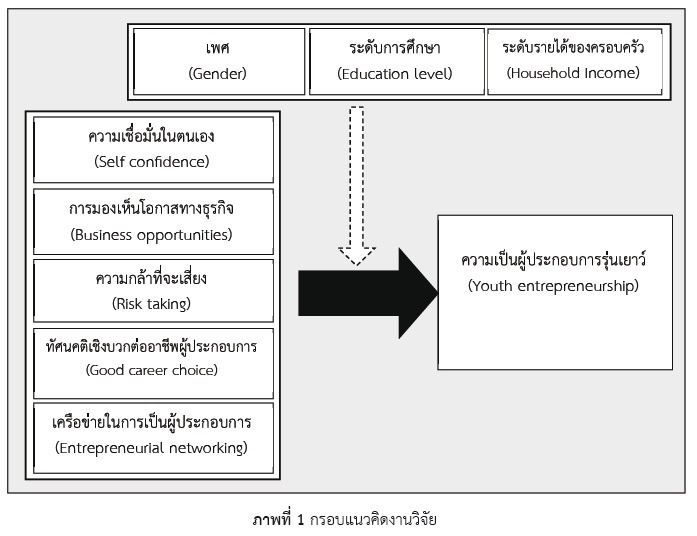Factors Influencing Youth Entrepreneurs in Thailand
Keywords:
Youth Entrepreneurship, Global Entrepreneurship Monitor (GEM), ThailandAbstract
The purpose of this study is to investigate the influences of antecedent factors toward entrepreneurship of Thai youth and young adults. Encouraging youth entrepreneurship is considered as one of the country’s national policies to solve Thai economics and social problems. Youth entrepreneurship is not only relieving youth’s unemployment problems but also creating more jobs
and innovation that lead to sustainable economic development of the nation. This research paper is based on Global Entrepreneurship Monitor (GEM) data during 2011 to 2015. The 4,480 samples of Thai citizen aging between 18-34 years old are analyzed by the logistic regression technique. The results reveal that the range of psychological factors; self-confidence, opportunity recognition, risk taking and positive attitude toward entrepreneurial occupation, result in positive effect regarding entrepreneurship of Thai youth and young adults. On the one hand, the entrepreneurial networking positively affects only entrepreneurship of young adults (25-34 years old) but not for Thai youth (18-24 years old). There are also a few interesting findings based on demographic factors. Thai female tends to become youth entrepreneurs more than male. In addition, the level of formal education has statistically significant negative relationship with entrepreneurship of Thai youth and young adults, while the level of household income shows no relationship effect toward both groups.
References
กัลยา วานิชย์บัญชา. (2551). การวิเคราะห์สถิติขั้นสูงด้วย SPSS for Windows. กรุงเทพมหานคร: ศูนย์หนังสือจุฬาลงกรณ์มหาวิทยาลัย.
องค์การทุนเพื่อเด็กแห่งสหประชาชาติ (2559). รายงานสถานการณ์วัยรุ่นและเยาวชนในประเทศไทย. สืบค้นจาก http://www.unicef.or.th/SitAnVideo2016/sitan_executive_summary.docx.
Ajzen, I. (1991). The theory of planned behavior. Organizational behavior and human decision processes, 50(2), 179-211.
Bendig, M., Unterberg, M., & Sarpong, B. (2012). Overview of the Microcredit Sector in the European Union for the Period 2010–2011. Brussels: European Microfinance Network.
Bosma, N., Coduras, A., Litovsky, Y., & Seaman, J. (2012). GEM Manual: A report on the design, data and quality control of the Global Entrepreneurship Monitor. Global Entrepreneurship Monitor, 1-95.
Cooper Ceptureanu, S. I. (2015). Knowledge Management in Romanian Young SMEs (Part 1). Revista de Management Comparat International, 16(1), 5.
Chigunta, F. J. (2002). Youth entrepreneurship: Meeting the key policy challenges (pp. 1-34). Education Development Center.
Fuchs, K., Werner, A., & Wallau, F. (2008). Entrepreneurship education in Germany and Sweden: what role do different school systems play?. Journal of small business and enterprise development, 15(2), 365-381.
Goksel, A. (2011). Gender, business education, family background and personal traits; A multi dimensional analysis of their affects on entrepreneurial propensity: Findings from Turkey. International Journal of Business and Social Science, 2(13).
Hofer, A. R., & Delaney, A. (2010). Shooting for the Moon: Good Practices in Local Youth Entrepreneurship Support. OECD Local Economic and Employment Development (LEED) Working Papers, 2010/11, OECD Publishing.
Holienka, M. (2014). Youth entrepreneurship in Slovakia: a GEM based perspective. Comenius Management Review, 8(2), 41-50.
Hundley, G. (2006). Family Background and the Propensity for Self-Employment. Industrial Relations: A Journal of Economy and Society, 45(3), 377-392.
International Labour Office. (2013). Global Employment Trends for Youth: A Generation at Risk. International Labour Organization, Geneva, Switzerland.
International Labour Office. (2015). World Employment and Social Outlook: Trends 2015. International Labour Organization, Geneva, Switzerland.
Koellinger, P., Minniti, M., & Schade, C. (2013). Gender differences in entrepreneurial propensity. Oxford bulletin of economics and statistics, 75(2), 213-234.
Krueger, N. F., Reilly, M. D., & Carsrud, A. L. (2000). Competing models of entrepreneurial intentions. Journal of business venturing, 15(5), 411-432.
Langowitz, N., & Minniti, M. (2007). The entrepreneurial propensity of women. Entrepreneurship theory and practice, 31(3), 341-364.
Levie, J., & Autio, E. (2011). Regulatory burden, rule of law, and entry of strategic entrepreneurs: An international panel study. Journal of Management Studies, 48(6), 1392-1419.
Malach Pines, A., Lerner, M., & Schwartz, D. (2010). Gender differences in entrepreneurship: equality, diversity and inclusion in times of global crisis. Equality, Diversity and Inclusion: An International Journal, 29(2), 186-198.
McMullen, J. S., Bagby, D., & Palich, L. E. (2008). Economic freedom and the motivation to engage in entrepreneurial action. Entrepreneurship Theory and Practice, 32(5), 875-895.
Mitchell, J. R., & Shepherd, D. A. (2010). To thine own self be true: Images of self, images of opportunity, and entrepreneurial action. Journal of Business Venturing, 25(1), 138-154.
Oosterbeek, H., Van Praag, M., & Ijsselstein, A. (2010). The impact of entrepreneurship education on entrepreneurship skills and motivation. European economic review, 54(3), 442-454.
Parker, S. C., & Belghitar, Y. (2006). What happens to nascent entrepreneurs? An econometric analysis of the PSED. Small Business Economics, 27(1), 81-101.
Pihie, Z. A. L., & Akmaliah, Z. (2009). Entrepreneurship as a career choice: An analysis of entrepreneurial self-efficacy and intention of university students. European journal of social sciences, 9(2), 338-349.
Pilkova, A., Holienka, M., & Rehak, J. (2014). Senior entrepreneurship in the perspective of European entrepreneurial environment. Procedia Economics and Finance, 12, 523-532.
Ramos-Rodriguez, A. R., Medina-Garrido, J. A., & Ruiz-Navarro, J. (2012). Determinants of hotels and restaurants entrepreneurship: A study using GEM data. International Journal of Hospitality Management, 31(2), 579-587.
Sapienza, H. J., & Grimm, C. M. (1997). Founder characteristics, start-up process, and strategy/structure variables as predictors of shortline railroad performance. Entrepreneurship: Theory and Practice, 22(1), 5-25.
Shapero, A., & Sokol, L. (1982). The social dimensions of entrepreneurship. Encyclopedia of entrepreneurship, 72-90.
Sequeira, J., Mueller, S. L., & McGee, J. E. (2007). The influence of social ties and self-efficacy in forming entrepreneurial intentions and motivating nascent behavior. Journal of Developmental Entrepreneurship, 12(03), 275-293.
Verheul, I., Thurik, R., Hessels, J., & van der Zwan, P. (2010). Factors influencing the entrepreneurial engagement of opportunity and necessity entrepreneurs. EIM Research Reports h, 201011, 1-24.
Von Graevenitz, G., Harhoff, D., & Weber, R. (2010). The effects of entrepreneurship education. Journal of Economic Behavior & Organization, 76(1), 90-112.
Williams, C. C. (2009). The motives of off-the-books entrepreneurs: necessity-or opportunity-driven?. International Entrepreneurship and Management Journal, 5(2), 203.
Wood, M. S., Williams, D. W., & Gregoire, D. A. (2012). The road to riches? A model of the cognitive processes and inflection points underpinning entrepreneurial action. Advances in entrepreneurship, firm emergence and growth, 14, 207-252.
World Economic Forum. (2014). Outlook on the Global Agenda 2015. Retrieved from http://www3.
weforum.org/docs/GAC14/WEF_GAC14_OutlookGlobalAgenda_Report.pdf
Wu, S., & Wu, L. (2008). The impact of higher education on entrepreneurial intentions of university students in China. Journal of Small Business and Enterprise Development, 15(4), 752-774.
Yaghmaei, O., & Ghasemi, I. (2015). Effects of Influential Factors on Entrepreneurial Intention of Postgraduate Students in Malaysia. International Letters of Social and Humanistic Sciences, 51, 115-124.

Downloads
Published
How to Cite
Issue
Section
License
Copyright (c) 2024 NIDA Business School, National Institute of Development Administration

This work is licensed under a Creative Commons Attribution-NonCommercial-NoDerivatives 4.0 International License.


